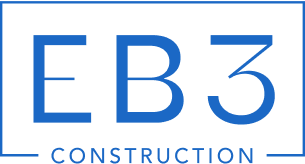Nine out of ten large construction projects exceed their original budgets, turning what should be profitable ventures into financial stress tests. This stark reality highlights why construction budget management has become the difference between projects that succeed and those that drain resources.
Construction budget management is the continuous process of planning, tracking, and adjusting project costs from kickoff to closeout. At EB3 Construction, we treat a budget as more than numbers on a spreadsheet—it serves as our financial roadmap that breaks costs into clear categories, aligns funding with scope, and supports critical decisions throughout project delivery.
What Cost Components Belong In A Construction Budget?

A comprehensive construction budget must capture all project-related expenses to ensure accurate financial planning and control. These costs fall into distinct categories, each serving a specific role in the overall project financial structure.
Hard Costs: The Physical Construction Elements
Hard costs represent the tangible, physical expenses directly tied to building the structure. These direct costs form the foundation of most construction budgets.
Labor and materials make up the largest portion of hard costs. Labor includes wages for skilled tradespeople, equipment operators, and field supervision. Materials encompass everything from concrete and steel to finish carpentry items and fixtures.
Equipment costs cover both owned and rented machinery needed for construction activities. This includes excavators, cranes, concrete pumps, and specialized tools. We factor in delivery, fuel, maintenance, and operator expenses when calculating equipment costs.
Subcontractor fees represent another significant hard cost component. These payments cover specialized trade work like electrical systems, plumbing, HVAC installation, and architectural specialties that require specific expertise and licensing.
Soft Costs: Essential Support Functions
Soft costs cover the indirect expenses necessary for project completion but not directly tied to physical construction work. Research shows these costs typically account for about 30% of total project expenses, though this percentage can approach 50% on complex projects.
Permits and fees include building permits, impact fees, utility connections, and inspection costs required by the authority having jurisdiction. These regulatory expenses vary significantly by location and project type.
Insurance and bonds protect all project stakeholders from various risks. General liability, workers’ compensation, builder’s risk, and performance bonds fall into this category. Professional services like architectural design, engineering, legal review, and project management overhead complete the soft cost picture.
Contingency Reserve: Financial Protection
Every construction budget requires a contingency fund to address unforeseen circumstances and cost variations. Standard practice calls for contingency reserves of 5-10% of total project costs.
Projects with higher complexity or risk profiles may warrant contingency reserves up to 20%. Factors that drive larger contingency needs include challenging site conditions, aggressive schedules, design complexity, and market volatility.
We size contingencies based on project-specific risk assessment rather than applying blanket percentages. This approach provides more accurate financial protection while avoiding unnecessary cost padding.
Profit Calculation And Project Viability
Profit represents the financial return after covering all project costs. The calculation is straightforward: Profit equals total revenue minus total costs.
Profit margins vary based on project type, market conditions, and contractor capabilities. Commercial projects typically yield different margins than residential work, and design-build contracts often provide different profit opportunities than traditional bid projects.
We establish target profit margins during the estimating phase and monitor actual performance throughout construction to ensure financial objectives remain achievable.
Cost Codes And Schedule Of Values For Control
Breaking the budget into detailed cost codes provides the granular control necessary for effective financial management. Cost codes align with industry standards like the Construction Specifications Institute (CSI) format, enabling consistent tracking across projects.
| Cost Component | Description | Percentage of Total Budget |
| Hard Costs | Labor, materials, equipment, subcontractor fees | 70-80% |
| Soft Costs | Permits, insurance, architectural and engineering fees | 20-30% |
| Contingency | Financial cushion for unexpected costs | 5-15% |
| Profit | Financial return after covering all costs | Varies |
Disclaimer: Pricing figures are based on publicly available market data and are intended for general estimation purposes as of November 2025. They do not represent a formal quote from EB3 Construction. Actual costs will vary by project scope, location, labor rates, and material prices.
A schedule of values organizes these costs into payment milestones tied to specific work completion. This document serves as the foundation for progress billing and helps maintain cash flow alignment with work progress.
The schedule of values breaks the total contract amount into discrete line items, each with defined scope and value. This structure supports accurate progress payments and provides transparency for all project stakeholders.
How Do You Build A Reliable Budget Step By Step?
Building a solid construction budget requires a systematic approach that captures every cost element before work begins. We start with project scope definition and move methodically through estimation, lifecycle planning, and system setup. This structured process ensures accuracy and provides the foundation for effective cost control throughout the project.
Establish Clear Project Scope
Project scope defines the boundaries of what we will deliver. We review all contract documents, drawings, and specifications to understand exactly what work is included and what falls outside our responsibility. Clear scope prevents costly misunderstandings later and forms the basis for all budget calculations.
We document any assumptions about site conditions, material availability, or regulatory requirements. These assumptions become critical reference points when actual conditions differ from expectations. Scope clarity also helps us communicate effectively with subcontractors during the bidding process.
Create A Work Breakdown Structure
The Work Breakdown Structure organizes the entire project into manageable work packages. We break down major deliverables into specific tasks that can be estimated, scheduled, and tracked. Each work package represents a discrete portion of the project with clear boundaries and deliverables.
Our WBS typically follows the construction phases: sitework, foundation, framing, mechanical systems, electrical, finishes, and closeout activities. We ensure every element from the project scope appears in the WBS to prevent missing costs. The structure also helps us assign responsibility and coordinate between different trades.
We code each work package using a consistent numbering system that aligns with our cost accounting structure. This coding system carries through to our estimates, schedules, and cost tracking systems for seamless integration.
Estimate Costs From The WBS
With the WBS complete, we estimate costs for each work package using current market data and historical project information. Labor estimates include base wages plus burden costs for taxes, insurance, and benefits. Material costs reflect current supplier pricing with consideration for delivery timing and potential escalation.
Equipment costs include both owned equipment (depreciation, maintenance, fuel) and rental equipment needed for specific tasks. We also estimate subcontractor costs by soliciting competitive bids or using recent pricing from similar work packages. Overhead costs cover project management, temporary facilities, and other indirect expenses necessary for project execution.
We validate our estimates against industry benchmarks and recent project data. Each estimate includes documented assumptions about productivity rates, material specifications, and construction methods. This documentation proves valuable when actual costs vary from estimates.
Calculate Expected Profit
Profit calculation follows the fundamental formula: Revenue minus Total Costs equals Profit. We determine the appropriate profit margin based on project risk, market conditions, and our strategic objectives. Higher-risk projects or those requiring specialized expertise typically warrant higher margins.
We consider both direct costs (labor, materials, subcontractors) and indirect costs (overhead, insurance, bonds) in our total cost calculation. The profit margin must cover general business overhead not allocated to specific projects and provide a reasonable return on investment. Market conditions and competitive factors influence the final margin we can achieve.
Align With Project Lifecycle Planning
Budget planning integrates with each phase of the project lifecycle to ensure realistic timing and cash flow projections. During the design phase, we refine estimates as drawings develop and specifications become more detailed. The preconstruction phase involves final subcontractor selection and material procurement planning.
Procurement timing affects both costs and cash flow, particularly for long-lead-time materials that require early ordering. The construction phase requires detailed cash flow planning to manage payment timing for labor, materials, and subcontractors. Closeout documentation ensures all final costs are captured and warranty responsibilities are clearly defined.
Each lifecycle phase has specific budget considerations and decision points. We build these timing factors into our estimates to create realistic project schedules and cash flow projections.
Document Assumptions And Market Inputs
Thorough documentation of our estimating assumptions protects against future disputes and provides a baseline for change order evaluation. We record material specifications, productivity assumptions, site condition expectations, and regulatory requirements used in our estimates.
Current market inputs include material costs, labor rates, and equipment pricing effective at the time of estimation. We note the source and date of all pricing information and identify any items subject to escalation or market volatility. Historical data from similar projects provides benchmarks for productivity and typical cost patterns.
This documentation becomes essential when project conditions change or when preparing estimates for future similar projects. We maintain detailed records that improve the accuracy of subsequent estimates.
Set Up Cost Codes And Reporting Early
Cost coding systems establish the framework for tracking actual costs against budget throughout the project. We implement cost codes that align with our WBS structure and provide the detail level needed for effective management. The coding system must accommodate both summary reporting for stakeholders and detailed analysis for project management.
Early setup of cost tracking systems allows us to capture actual costs from day one of construction. We train project teams on proper cost coding procedures to ensure accurate job cost allocation. Integration between our estimating, accounting, and project management systems streamlines data flow and reduces errors.
Regular reporting intervals and variance analysis procedures are established before construction begins. This early setup enables proactive cost management rather than reactive corrections after problems develop.
Which Factors And Risks Move The Budget, And How Do You Control Them?

Material price fluctuations rank among the most significant drivers of budget variance. Steel prices can shift 20-30% within months based on global supply chains and trade policies. Lumber costs proved this during COVID-19 disruptions, creating unexpected increases for projects already under contract.
Site conditions present another major risk category. Poor soil bearing capacity discovered during excavation can trigger foundation redesigns and delays. Access limitations may require smaller equipment or extended work hours, both costly adjustments we account for during initial site evaluation.
Environmental And Regulatory Pressures
Climate factors influence both scheduling and costs. Severe weather extends timelines and increases labor inefficiencies. We monitor seasonal patterns and build weather delays into project schedules based on historical data for each region.
Regulatory requirements from the authority having jurisdiction (AHJ) can shift during long construction cycles. Code updates, permit modifications, or inspection protocol changes create both direct costs and schedule impacts. We maintain relationships with local building departments to stay ahead of regulatory changes.
Common Project Risk Categories
Misallocated job costs represent a frequent but preventable risk. When crews charge time to incorrect cost codes, variance analysis becomes unreliable and budget control breaks down. This creates false signals about where money is actually being spent across work packages.
Scope changes emerge from design evolution, owner requests, or unforeseen field conditions. Each change ripples through the schedule and budget, often affecting multiple trades and work sequences. Change order impacts extend beyond the immediate work to coordination and logistics costs.
Underestimation during initial budgeting stems from incomplete scope definition, optimistic productivity assumptions, or inadequate contingency planning. Historical data from similar projects provides the most reliable foundation for realistic cost projections.
Risk Control Strategies
We size contingency reserves based on project complexity and risk profile. Standard projects typically warrant 5-10% contingency, while complex or first-of-kind work may require 15-20% or higher. The contingency allocation reflects specific risk exposure rather than arbitrary percentages.
Force majeure clauses in contracts help manage risks beyond anyone’s control. These provisions define how extraordinary events like natural disasters, labor strikes, or supply chain disruptions get handled financially and schedularly between project parties.
Cost coding training ensures accurate job cost allocation from day one. We establish clear protocols for time and material charges, train foremen and administrative staff on proper procedures, and conduct regular audits to maintain data integrity.
Work-in-Progress (WIP) accounting provides early variance detection by comparing actual costs to budget and earned progress monthly. This real-time visibility allows us to identify trends before they become major overruns and take corrective action quickly.
Dynamic Risk Management
We reassess allowances and contingencies as conditions change throughout the project lifecycle. Market conditions, design maturity, and construction progress all influence remaining risk exposure. Regular risk reviews with project stakeholders ensure our mitigation strategies stay current.
| Risk Factor | Control Strategy |
| Material price fluctuations | Monitor supply chains; reassess allowances and contingencies |
| Site conditions | Initial site evaluation; assess soil bearing capacity |
| Environmental and regulatory pressures | Maintain relationships with local authorities; monitor legislative changes |
| Misallocated job costs | Cost coding training; regular audits |
| Scope changes | Standardized change order workflows; document scope assumptions |
| Underestimation | Use historical data for benchmark comparisons; thorough documentation of assumptions |
Variance analysis compares planned versus actual performance across all cost categories. This analysis reveals patterns in cost drivers and helps refine estimating accuracy for future projects. We document lessons learned from each project to improve our risk assessment capabilities.
What Practices And Tools Keep Budgets On Track During Delivery?
Digital Cost Management Systems
We use integrated construction budgeting software to centralize all cost data across projects. These systems connect directly to accounting platforms, payroll systems, and field applications. Real-time budget tracking eliminates the lag between field activities and financial reporting.
Digital platforms pull data from multiple sources automatically. Purchase orders, invoices, and timesheet entries update cost records without manual input. This integration prevents data silos that often lead to budget surprises late in construction.
Modern cost management systems also handle complex approval workflows. Multiple stakeholders can review and approve expenditures remotely. This speeds decision-making while maintaining proper financial controls.
Frequent Cost Plan Updates And Reporting
Regular cost reporting keeps all team members aligned on project financial health. We distribute cost summaries weekly, highlighting variances against baseline budgets. Clear formatting makes these reports accessible to both field personnel and executives.
Cost reports include trend analysis and forward-looking projections. When material costs shift or labor productivity changes, updated forecasts help teams adjust strategies proactively. Early detection of budget drift allows corrective action before problems compound.
Stakeholder communication extends beyond internal teams. Regular budget updates to owners, lenders, and development partners maintain transparency throughout project delivery.
Standardized Change Order Workflows
Change order management directly impacts budget control. We establish clear procedures for identifying, documenting, and approving scope changes. Standardized forms capture all necessary details including cost impacts and schedule implications.
Digital change order systems expedite approval cycles. Mobile applications allow field teams to document changes immediately with photos and descriptions. Automated routing ensures proposals reach decision-makers quickly.
Every change order links to specific cost codes and budget line items. This connection maintains budget integrity even as project scope evolves. Quick processing prevents work delays while protecting financial interests.
Cash Flow Monitoring And Forecasting
Active cash flow management prevents funding gaps during construction. We track payment applications, retention schedules, and upcoming major expenditures. Cash flow forecasting extends twelve weeks forward, accounting for typical payment cycles.
Scenario analysis helps evaluate potential impacts of schedule changes or scope modifications. Different completion scenarios show varying cash requirements. This planning enables proactive financing discussions with project stakeholders.
Payment timing coordination also affects cash flow. We align subcontractor payments with owner receipts when possible. This matching reduces working capital requirements and improves project profitability.
Performance Dashboards And Variance Analysis
Real-time dashboards provide immediate visibility into project financial performance. Key metrics include cost per square foot, labor productivity rates, and budget consumption against schedule progress. Visual indicators highlight areas requiring attention.
Variance analysis compares actual performance to budgeted expectations across all cost categories. We investigate variances exceeding predetermined thresholds immediately. Item-level tracking identifies specific causes of budget deviations.
Earned value management provides additional performance insights where project complexity warrants detailed analysis. Cost Performance Index (CPI) shows spending efficiency relative to work completed. Schedule Performance Index (SPI) reveals whether progress aligns with planned timelines. Estimate at Completion (EAC) projects final costs based on current performance trends.
Historical Data For Continuous Improvement
Historical project data improves future budget accuracy and informs current project adjustments. When actual costs diverge significantly from budgeted amounts, we analyze underlying causes. Market conditions, productivity factors, and scope interpretation all influence final outcomes.
This analysis guides allowance recalibration during active projects. If steel costs exceed budget assumptions due to market volatility, we adjust remaining procurement forecasts accordingly. Historical trends also inform contingency usage decisions.
Performance benchmarking across similar projects reveals patterns in cost overruns or savings. These insights strengthen our estimating processes and help clients understand typical project risks and opportunities.
Conclusion and Next Steps

Successful construction budget management requires discipline, clear systems, and consistent execution. We build budgets from a solid work breakdown structure that captures every task and deliverable. All cost categories matter, from labor and materials to permits and project management overhead. Contingency sizing must align with actual project risk, typically 5-10% for standard work and higher for complex builds or uncertain conditions.
Financial control depends on tracking systems that provide visibility when it counts. Clear cost codes organize expenses and enable accurate reporting. WIP accounting reveals variances early, before they compound into major overruns. Real-time tools centralize data and keep stakeholders informed as conditions change. We standardize change order workflows and train teams on proper cost coding to maintain accuracy throughout delivery. Dashboards and variance analysis help us act quickly when performance diverges from plan. Regular budget reviews allow us to recalibrate allowances and adjust forecasts as markets, scope, and site realities shift. Contact EB3 to discuss how we implement these financial controls on your next project.




